11 Best Herbal Teas For Migraine
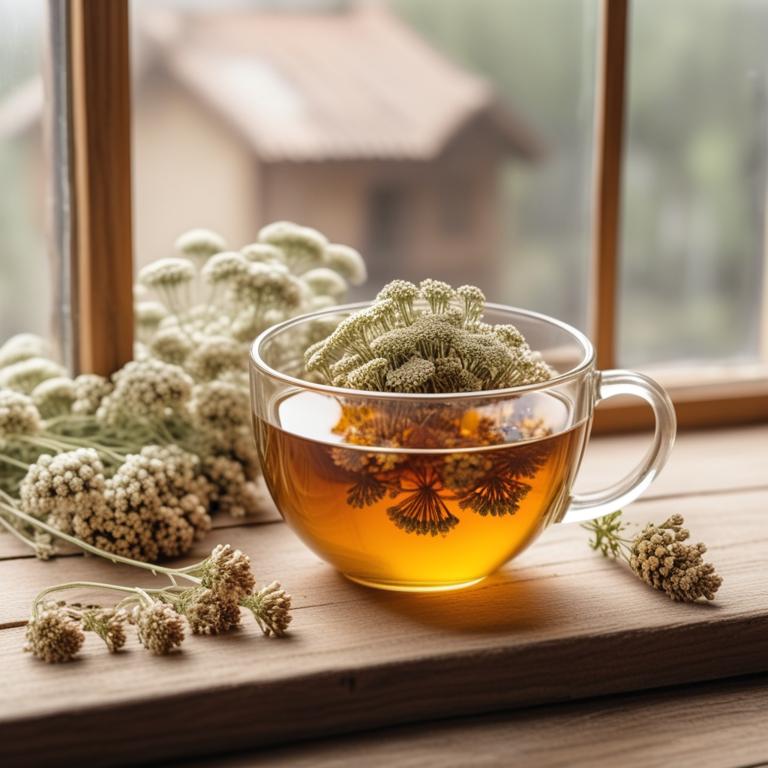
Herbal teas for Migraine are a natural remedy that involves the consumption of plant-based teas to alleviate the symptoms of migraine headaches.
These teas are effective in treating migraines because they contain properties that help to relax tense muscles, reduce inflammation, and improve blood flow, thereby providing relief from the pain and discomfort associated with migraines.
Examples of herbal teas that can be used to treat migraines include feverfew, which contains a compound called parthenolide that helps to reduce inflammation and prevent migraine attacks; ginger, which has anti-inflammatory properties that can help to alleviate pain and nausea; peppermint, which can help to relax tense muscles and improve blood flow; lavender, which has a calming effect that can help to reduce stress and anxiety; and passionflower, which contains a compound called flavonoids that can help to reduce inflammation and promote relaxation.
Additionally, other herbal teas such as willow bark, which contains salicin, a compound similar to aspirin, and skullcap, which has anti-inflammatory and pain-relieving properties, can also be used to treat migraines.
Related Study
According to Phytotherapy research : PTR, teas for migraine, such as those containing feverfew, butterbur, curcumin, menthol/peppermint oil, coriander, citron, and chamomile, may present potential options to enhance the treatment of migraine, although further high-quality research is necessary to confirm their efficacy and safety.
Below there's a list of the 11 best herbal teas for migraine.
Table of Contents
Also, you may be interested in...
Today Free Bonus!
The Ultimate Herb Drying Checklist
(For Long-Lasting Powerful Medicinal Effect)
How to easily dry herbs that don't mold and that keep their strong medicinal power for more than 1 year.
1. Foeniculum vulgare teas
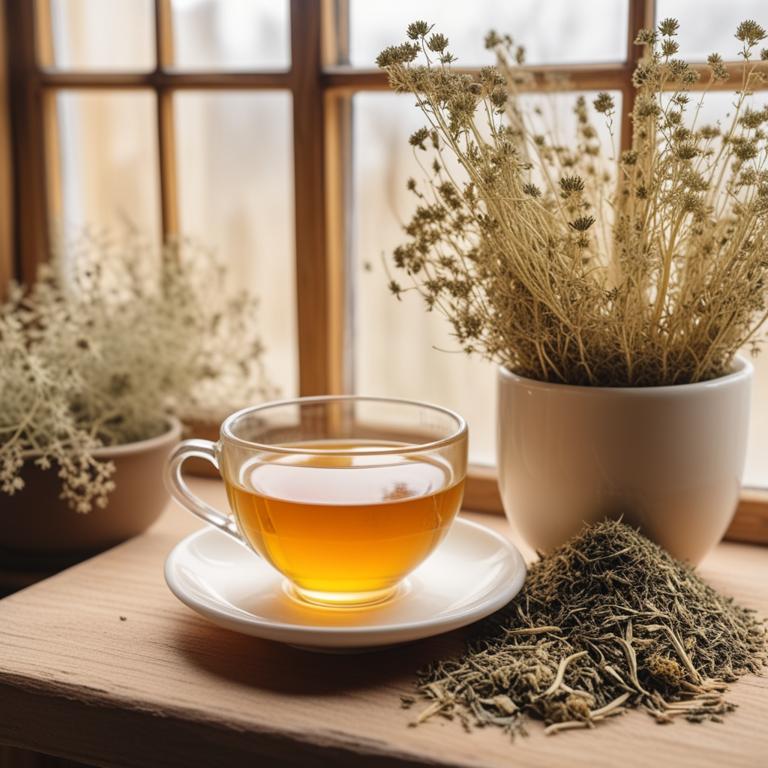
Foeniculum vulgare teas, also known as fennel tea, have been used for centuries to treat migraine ailments due to their anti-inflammatory and analgesic properties.
The tea helps to treat migraines by reducing inflammation and relaxing tense muscles, which in turn relieves pain and discomfort.
The bioactive constituents of fennel tea, including anethole, limonene, and flavonoids, contribute to its therapeutic effects by modulating neurotransmitters and reducing oxidative stress.
The benefits of fennel tea in treating migraines include its ability to provide rapid relief from symptoms, reduce the frequency and severity of attacks, and promote overall well-being.
Recipe:
- Gather 1 cup of boiling water and 1 teaspoon of dried Foeniculum vulgare (also known as fennel seeds).
- Add the fennel seeds to a teapot or a heat-resistant cup.
- Steep the fennel seeds in the boiling water for 5-7 minutes.
- Strain the tea into a cup and add honey to taste, if desired.
- Drink the tea slowly and comfortably to help alleviate migraine symptoms.
Foeniculum vulgare teas can be used to alleviate migraine symptoms, but they may cause side effects such as dizziness, nausea, and allergic reactions in some individuals.
When using Foeniculum vulgare teas to treat migraines, it is essential to be cautious, as excessive consumption may lead to interactions with other medications, exacerbate digestive issues, and worsen conditions such as diabetes or low blood pressure.
Foeniculum Vulgare Tea on Amazon
Fennel Tea - 100% Organic and Alkaline - 15 Unbleached/Chemical-Free Fennel Tea Bags - Caffeine-Free, No GMO
Disclaimer: We earn a commission if you click this link and make a purchase at no additional cost to you.
2. Zingiber officinale teas

Zingiber officinale teas have been traditionally used to treat migraine due to their analgesic and anti-inflammatory properties, which help to alleviate migraine symptoms such as pain and discomfort.
The bioactive constituents of Zingiber officinale, including gingerols and shogaols, possess potent anti-inflammatory and analgesic activities that contribute to its therapeutic effects.
By inhibiting the production of pro-inflammatory mediators and modulating pain-sensing pathways, Zingiber officinale teas help to reduce migraine severity and frequency.
The benefits of using Zingiber officinale teas to treat migraine include reduced frequency and severity of attacks, improved quality of life, and a lower reliance on conventional pain medications.
Related Study
According to "Journal of ethnopharmacology", Zingiber officinale teas for migraine may exert both abortive and prophylactic effects without any side-effects.
Recipe:
- Boil 1 cup of water in a pot.
- Take 1 teaspoon of fresh ginger root and slice it into thin pieces.
- Add the sliced ginger to the boiling water and let it steep for 5 minutes.
- Strain the tea into a cup and discard the ginger pieces.
- Drink the tea hot or let it cool down to your liking.
Zingiber officinale teas can be used as a potential remedy for migraines, but it may cause side effects such as stomach upset, nausea, and diarrhea due to its spicy and warming properties.
To use Zingiber officinale teas effectively, it's recommended to start with a small dose and gradually increase it to minimize side effects, and also to drink plenty of water to help alleviate stomach discomfort and to avoid taking it before bedtime to prevent sleep disturbances.
Zingiber Officinale Tea on Amazon
FGO Organic Ginger Tea, 100 Count, Eco-Conscious Tea Bags, Caffeine Free, Packaging May Vary (Pack of 1)
Disclaimer: We earn a commission if you click this link and make a purchase at no additional cost to you.
3. Valeriana officinalis teas

Valeriana officinalis teas have been traditionally used to treat migraine ailments due to their sedative, anti-inflammatory, and pain-relieving properties.
The herbal preparation helps to treat migraines by reducing muscle tension, relaxing the mind, and alleviating symptoms such as pain, nausea, and sensitivity to light.
The bioactive constituents of Valeriana officinalis, including valerenic acid, isovaleric acid, and valepotriates, contribute to its therapeutic effects by modulating the GABA receptor, reducing inflammation, and blocking pain pathways.
The benefits of using Valeriana officinalis teas to treat migraines include reduced frequency and severity of episodes, improved sleep quality, and a sense of calm and relaxation.
Related Study
According to the study, Valeriana officinalis teas may be beneficial in reducing pain associated with migraines, as its root extract showed significant analgesic effects in both acute and chronic phases of pain.
Recipe:
- Gather 1 cup of fresh Valeriana officinalis roots or 2-3 tablespoons of dried roots.
- Use a tea infuser or a heat-resistant cup to steep the roots in 1 cup of boiling water for 5-7 minutes.
- Strain the liquid into another cup, discarding the roots.
- Add honey to taste, if desired, to make the tea sweeter.
- Drink the tea 2-3 times a day to help alleviate migraine symptoms.
Valeriana officinalis teas can be effective in alleviating migraine symptoms, but possible side effects include drowsiness, stomach upset, and interactions with certain medications that may exacerbate the condition.
To use Valeriana officinalis teas safely, it is essential to start with a low dose and gradually increase as needed, avoid consuming it before driving or operating heavy machinery, and be aware of potential interactions with other herbal remedies or medications.
Valeriana Officinalis Tea on Amazon
Frontier Co-op Cut and Sifted Valerian Root 1lb, Kosher - for Valerian Root Tea, DIY Supplement Capsules, Bedtime Formulas and Sleep Pillows
Disclaimer: We earn a commission if you click this link and make a purchase at no additional cost to you.
4. Lavandula angustifolia teas
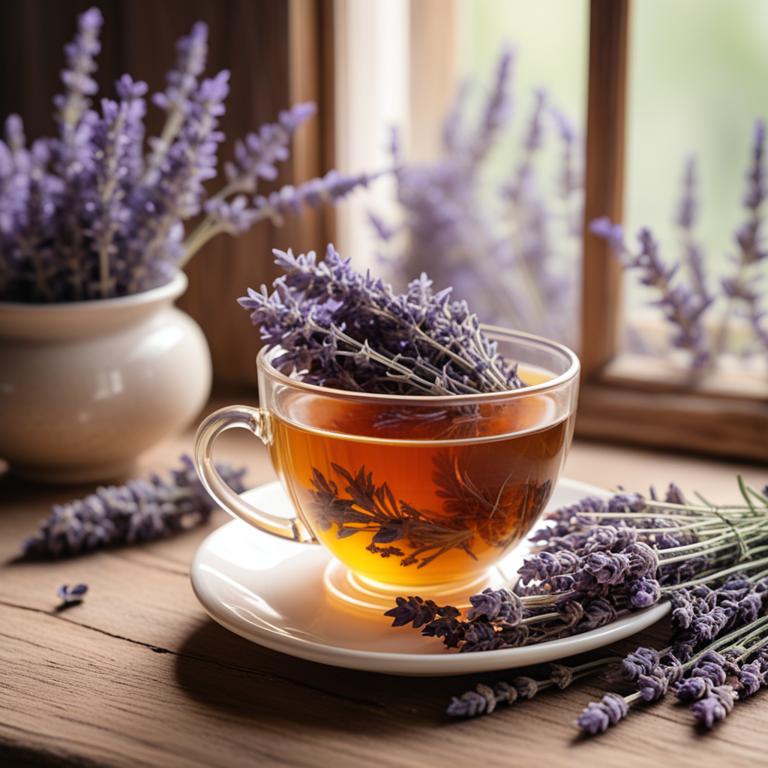
Lavandula angustifolia teas have been traditionally used to treat migraines due to their calming and analgesic properties, which help to soothe the nervous system and alleviate pain.
The herbal preparation contains bioactive constituents such as linalool and linalyl acetate, which are known for their anti-inflammatory and antispasmodic effects, helping to reduce migraine symptoms.
The benefits of using Lavandula angustifolia teas to treat migraines include reduced frequency and severity of attacks, improved sleep quality, and a decrease in anxiety and stress levels, leading to a better overall quality of life.
By incorporating Lavandula angustifolia teas into one's treatment plan, individuals may experience a reduction in migraine-related discomfort and an improvement in their overall well-being.
Recipe:
- Gather 1 cup of dried Lavandula angustifolia flowers.
- Use 2 tablespoons of the dried flowers for every cup of boiling water.
- Heat 1 cup of water in a pot and bring it to a boil.
- Add the 2 tablespoons of dried Lavandula angustifolia flowers to the boiling water and let it steep for 5-7 minutes.
- Strain the tea into a cup and let it cool down before drinking.
Lavandula angustifolia teas can be used as a potential treatment for migraines, but it may cause side effects such as drowsiness, stomach upset, and allergic reactions in some individuals.
To minimize potential side effects, it is recommended to start with small doses, avoid consuming the tea before driving or operating heavy machinery, and discontinue use if any adverse reactions occur.
Lavandula Angustifolia Tea on Amazon
Tiesta Tea - Lavender Chamomile Herbal Tea | Loose Leaf | Calming Blend with Chamomile and Lavender | Caffeine-Free Herbal | Great for Hot or Iced Brews | Resealable Bulk Pouch, 200 Cups | 8 Ounce
Disclaimer: We earn a commission if you click this link and make a purchase at no additional cost to you.
5. Ginkgo biloba teas

Ginkgo biloba teas have been traditionally used to treat migraine ailments due to their anti-inflammatory and vasodilatory properties.
This herbal preparation helps to treat migraine by improving blood circulation, reducing blood vessel spasms, and alleviating pain.
The bioactive constituents of Ginkgo biloba, including flavonoids, terpenoids, and bilobalide, contribute to its therapeutic effects by inhibiting platelet aggregation and enhancing nitric oxide production, ultimately leading to vasodilation and pain relief.
Regular consumption of Ginkgo biloba teas has been associated with reduced frequency and severity of migraines, making it a popular natural remedy for this condition.
Related Study
According to "Presse medicale (Paris, France : 1983)", Ginkgo biloba teas for migraine may provide significant pain relief and improved walking tolerance for patients with migraine symptoms, although the study specifically focused on arteritis.
Recipe:
- Gather 1 cup of water and 1 teaspoon of dried Ginkgo biloba leaves.
- Boil the water in a kettle or on the stove.
- Add the Ginkgo biloba leaves to a tea infuser or a small muslin bag.
- Steep the Ginkgo biloba leaves in the boiling water for 5-7 minutes.
- Strain the tea and drink 1 cup, 2-3 times a day, to help with migraines.
Ginkgo biloba teas can help alleviate migraine symptoms, but possible side effects include dizziness, nausea, and stomach upset in some individuals.
To minimize potential side effects, it's recommended to start with a low dose and gradually increase as needed, and to avoid consuming the tea before or after surgery, as it may affect blood clotting and anesthesia.
Ginkgo Biloba Tea on Amazon
Tai Chi Think Sharp Energizing Tea (Ginseng Ginkgo Biloba) 12 Bags
Disclaimer: We earn a commission if you click this link and make a purchase at no additional cost to you.
6. Achillea millefolium teas
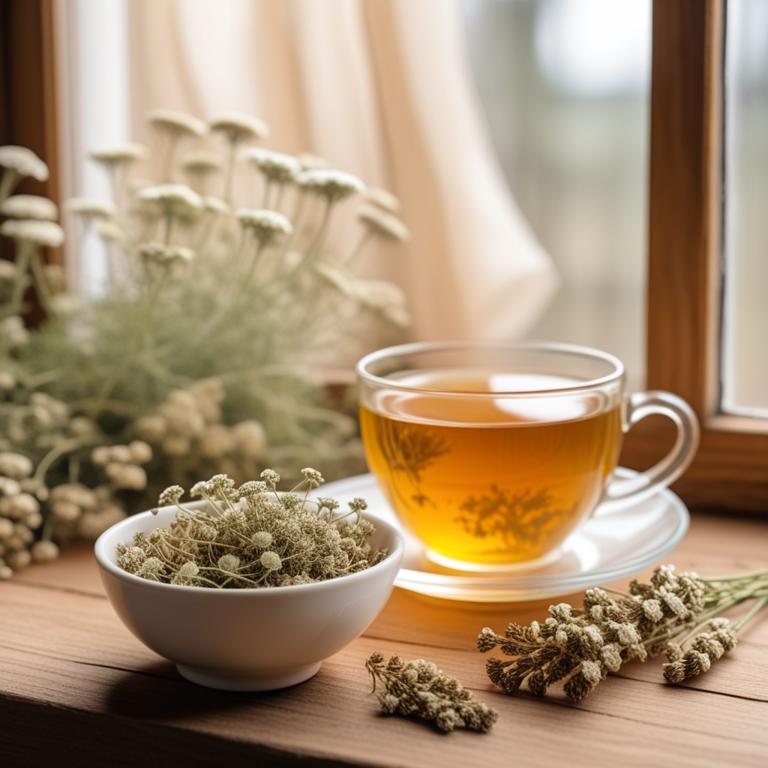
Achillea millefolium teas, also known as yarrow tea, have been traditionally used to treat migraine headaches due to their anti-inflammatory and antispasmodic properties.
The bioactive constituents of this herbal preparation, including flavonoids, sesquiterpenes, and volatile oils, help to relax blood vessels and reduce pain, thereby alleviating migraine symptoms.
The benefits of this herbal preparation in treating migraine include its ability to reduce frequency and severity of attacks, improve sleep quality, and alleviate nausea and vomiting associated with migraines.
By promoting relaxation and reducing inflammation, Achillea millefolium teas offer a natural and effective treatment option for individuals suffering from migraine headaches.
Recipe:
- Gather 1 cup of dried Achillea millefolium flowers and 1 cup of boiling water.
- Measure 1 teaspoon of dried flowers and add to a teapot or heat-resistant cup.
- Pour 1 cup of boiling water over the flowers and let steep for 5-7 minutes.
- Strain the tea into a cup and discard the flowers.
- Drink 1/2 cup of the tea, 2-3 times a day, as needed for migraine relief.
Achillea millefolium teas can be used to treat migraines, but some possible side effects include stomach upset, dizziness, and allergic reactions in rare cases.
When using Achillea millefolium teas to treat migraines, precautions to take include not consuming it in large quantities, avoiding it if you have sensitive stomach issues, and being aware of any allergic reactions that may occur.
Achillea Millefolium Tea on Amazon
Biokoma Pure and Organic Yarrow Dried Herb 30 Tea Bags 1.5oz In Resealable Moisture Proof Pouch, USDA Certified Organic - Herbal Tea, No Additives, No Preservatives, No GMO, Kosher
Disclaimer: We earn a commission if you click this link and make a purchase at no additional cost to you.
7. Passiflora incarnata teas

Passiflora incarnata teas have been traditionally used to treat migraines due to their sedative and anti-anxiety properties, which help to alleviate the symptoms of this debilitating condition.
The herbal preparation works by reducing inflammation and modulating the neurotransmitters that are involved in the pathophysiology of migraines, thereby providing relief from the pain and discomfort associated with this ailment.
The bioactive constituents of Passiflora incarnata teas, including flavonoids, alkaloids, and glycosides, have been shown to possess analgesic, anti-inflammatory, and anticonvulsant properties, which contribute to their effectiveness in treating migraines.
Regular consumption of Passiflora incarnata teas has been found to provide numerous benefits in treating migraines, including rapid pain relief, reduced frequency and severity of attacks, and improved overall quality of life.
Related Study
According to the study, Passiflora incarnata teas may have potential benefits in managing migraine due to the predicted pleiotropic effects of its phytoconstituents, including anticonvulsant, antidepressant, and nootropic activities.
Recipe:
- Gather 1 cup of fresh Passiflora incarnata flowers and 1 cup of water.
- Wash the flowers with clean water to remove dirt.
- Combine the flowers and water in a saucepan and bring to a boil.
- Reduce heat and let simmer for 10-15 minutes, then strain the mixture.
- Drink 1 cup of the tea 2-3 times a day as needed for migraine relief.
Passiflora incarnata teas can be used to treat migraine, but its use may be associated with potential side effects such as drowsiness, dizziness, and stomach upset in some individuals.
When using Passiflora incarnata teas to treat migraine, take precautions to avoid interactions with other medications, consume it in moderation, and be aware of its effects on cognitive function and driving ability.
Passiflora Incarnata Tea on Amazon
Traditional Medicinals Organic Nighty Night Tea, 16 Tea Bags (Pack of 1)
Disclaimer: We earn a commission if you click this link and make a purchase at no additional cost to you.
8. Melissa officinalis teas

Melissa officinalis teas, also known as lemon balm tea, have been used for centuries to treat migraine ailments due to their calming and soothing properties.
The tea's ability to reduce stress and anxiety helps to alleviate migraine symptoms by promoting relaxation and reducing muscle tension.
Bioactive constituents such as rosmarinic acid, apigenin, and luteolin in Melissa officinalis teas have been found to possess anti-inflammatory and antispasmodic properties, which help to reduce pain and inflammation associated with migraines.
The benefits of using Melissa officinalis teas to treat migraines include improved sleep quality, reduced frequency and severity of migraine attacks, and a decrease in overall stress levels.
Recipe:
- Gather 1 tablespoon of dried Melissa officinalis leaves and 1 cup of boiling water.
- Steep the leaves in the boiling water for 5-7 minutes.
- Strain the mixture through a fine-mesh sieve into a cup.
- Add honey to taste, if needed, to sweeten the tea.
- Drink the tea when you feel a migraine coming on or as directed by a healthcare professional.
Melissa officinalis teas can be used to treat migraines, but it may cause side effects such as dizziness, nausea, and stomach upset in some individuals due to its high concentration of volatile oils.
Precautions include taking the teas in moderation, avoiding consumption before driving or operating heavy machinery, and being aware of potential allergic reactions, especially when consumed in large quantities.
Melissa Officinalis Tea on Amazon
Maxx Herb Lemon Balm Extract - Max Strength Liquid Tincture Absorbs Better Than Capsules or Tea, for Nervous System Support, & Stress Management - Alcohol Free - 4 Oz Bottle (60 Servings)
Disclaimer: We earn a commission if you click this link and make a purchase at no additional cost to you.
9. Cinnamomum verum teas

Cinnamomum verum teas, also known as Ceylon cinnamon, have been traditionally used to treat migraine ailments due to their analgesic, anti-inflammatory, and antioxidant properties.
The bioactive constituents of Cinnamomum verum teas, including cinnamaldehyde, eugenol, and linalool, help to treat migraines by reducing inflammation, relieving pain, and modulating neurotransmitter activity.
The benefits of using Cinnamomum verum teas to treat migraines include reduced frequency and severity of attacks, improved sleep quality, and enhanced overall well-being.
By incorporating Cinnamomum verum teas into one's daily routine, individuals may experience relief from migraine symptoms and improved quality of life.
Recipe:
- Gather 1 teaspoon of Cinnamomum verum powder and 1 cup of boiling water.
- Steep the powder in the boiling water for 5-7 minutes.
- Strain the mixture into a cup to remove the powder.
- Add 1 tablespoon of honey (optional) to the tea and mix well.
- Drink the tea immediately and repeat as needed, but not more than 2 cups per day.
Cinnamomum verum teas can potentially alleviate migraine symptoms, but its use may also lead to side effects such as stomach upset, diarrhea, and allergic reactions in some individuals.
Precautions should be taken when consuming Cinnamomum verum teas for migraines, including monitoring blood sugar levels due to its potential to lower blood sugar, and avoiding excessive consumption, as it may cause liver damage or interact with certain medications.
Cinnamomum Verum Tea on Amazon
Lavendium, 20 Pure Cinnamon Tea Bags, Made of 100% Natural Cinnamon Sticks, Cinnamon Herbal Tea, No Additives, No Caffeine, No Gluten, Vegan.
Disclaimer: We earn a commission if you click this link and make a purchase at no additional cost to you.
10. Rosmarinus officinalis teas

Rosmarinus officinalis teas, made from the fragrant herb rosemary, have been traditionally used to treat migraine ailments due to their anti-inflammatory, antioxidant, and analgesic properties.
The bioactive constituents of rosemary tea, including carnosic acid and rosmarinic acid, help to reduce inflammation and alleviate migraine symptoms by inhibiting the production of pro-inflammatory enzymes and promoting relaxation.
Drinking rosemary tea may also help to treat migraines by reducing muscle tension, improving blood flow, and modulating neurotransmitter activity.
The benefits of using rosemary tea to treat migraines include reduced frequency and severity of episodes, improved overall well-being, and a natural, non-pharmacological approach to managing this debilitating condition.
Recipe:
- Gather 1 cup of boiling water and 1 tablespoon of dried Rosmarinus officinalis leaves.
- Measure 1 teaspoon of honey (optional) and set aside.
- Steep the Rosmarinus officinalis leaves in the boiling water for 5-7 minutes.
- Strain the mixture into a cup and discard the leaves.
- Add the honey (if using) and stir well to make the tea ready for consumption.
Rosmarinus officinalis teas can help alleviate migraine symptoms, but possible side effects include dizziness, nausea, and stomach upset in some individuals.
To minimize these side effects, it is recommended to start with a low dose and gradually increase as needed, and to avoid consuming the tea on an empty stomach to prevent stomach upset.
Rosmarinus Officinalis Tea on Amazon
Palm Beach Medicinal Herbs - Rosemary Tea - Pure Herbal Tea Series, 30ct
Disclaimer: We earn a commission if you click this link and make a purchase at no additional cost to you.
11. Mentha x piperita teas
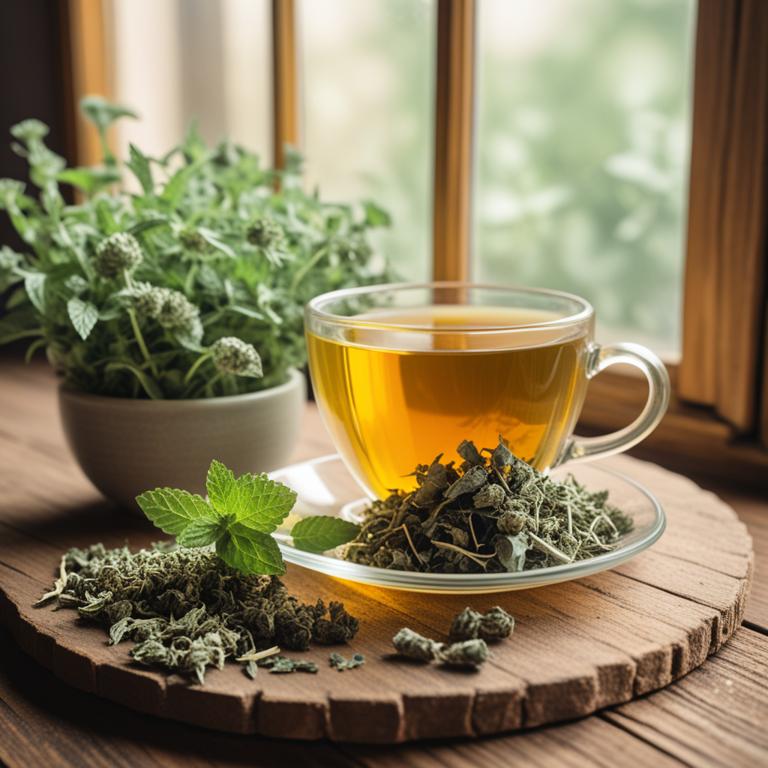
Mentha x piperita teas, also known as peppermint teas, have been widely used to treat the migraine ailment due to their analgesic, anti-inflammatory, and vasodilatory properties.
The active constituents of peppermint, including menthol and menthone, help to alleviate migraine symptoms by relaxing tense muscles, reducing pain, and improving blood flow to the brain.
The bioactive compounds present in peppermint teas, such as flavonoids and phenolic acids, also contribute to their anti-inflammatory and antioxidant effects, which can help to reduce the severity and frequency of migraine attacks.
Regular consumption of peppermint teas has been associated with several benefits, including reduced migraine frequency, improved sleep quality, and a decrease in overall stress levels.
Related Study
According to "Phytotherapy research : PTR", Mentha x piperita teas, also known as peppermint oil, showed positive, preliminary findings as an acute treatment for migraine.
Recipe:
- Gather 1 tablespoon of fresh Mentha x piperita leaves or 1 teaspoon of dried Mentha x piperita leaves.
- Boil 1 cup of water in a pot.
- Pour the boiling water over the Mentha x piperita leaves in a cup.
- Let it steep for 5-7 minutes, then strain the leaves from the tea.
- Drink the tea when it's still warm, ideally 2-3 times a day to help with migraine relief.
Mentha x piperita teas can provide relief from migraine symptoms, but possible side effects include stomach upset, dizziness, and allergic reactions such as skin rashes or itching.
When using Mentha x piperita teas to treat migraines, precautions should be taken, such as drinking the tea in moderation, avoiding it during pregnancy or breastfeeding, and being aware of potential interactions with other medications.